There be句型的用法
- 格式:doc
- 大小:59.50 KB
- 文档页数:4
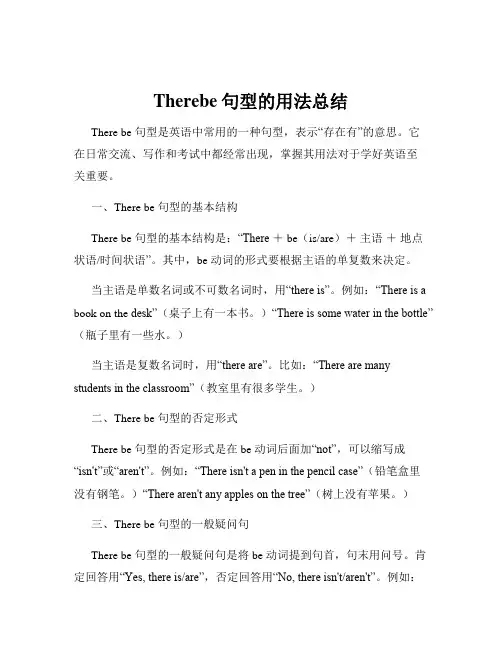
Therebe句型的用法总结There be 句型是英语中常用的一种句型,表示“存在有”的意思。
它在日常交流、写作和考试中都经常出现,掌握其用法对于学好英语至关重要。
一、There be 句型的基本结构There be 句型的基本结构是:“There + be(is/are)+主语+地点状语/时间状语”。
其中,be 动词的形式要根据主语的单复数来决定。
当主语是单数名词或不可数名词时,用“there is”。
例如:“There is a book on the desk”(桌子上有一本书。
)“There is some water in the bottle”(瓶子里有一些水。
)当主语是复数名词时,用“there are”。
比如:“There are many students in the classroom”(教室里有很多学生。
)二、There be 句型的否定形式There be 句型的否定形式是在 be 动词后面加“not”,可以缩写成“isn't”或“aren't”。
例如:“There isn't a pen in the pencil case”(铅笔盒里没有钢笔。
)“There aren't any apples on the tree”(树上没有苹果。
)三、There be 句型的一般疑问句There be 句型的一般疑问句是将 be 动词提到句首,句末用问号。
肯定回答用“Yes, there is/are”,否定回答用“No, there isn't/aren't”。
例如:“Is there a library in your school?”(你们学校有图书馆吗?)“Yes, there is” (是的,有。
)“Are there any flowers in the garden?”(花园里有花吗?)“No, there aren't” (不,没有。
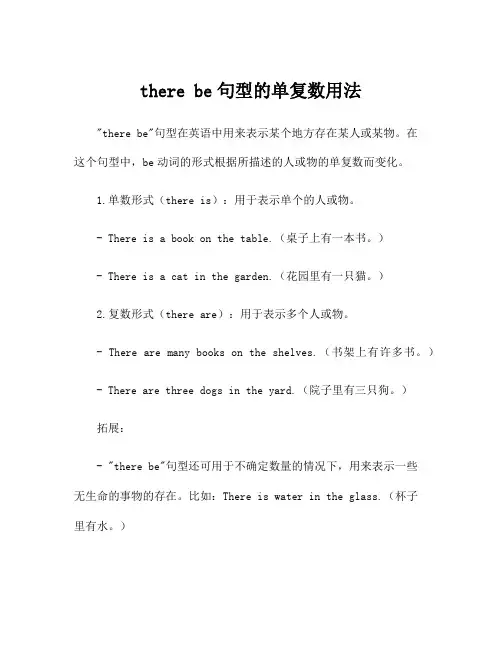
there be句型的单复数用法"there be"句型在英语中用来表示某个地方存在某人或某物。
在这个句型中,be动词的形式根据所描述的人或物的单复数而变化。
1.单数形式(there is):用于表示单个的人或物。
- There is a book on the table.(桌子上有一本书。
)- There is a cat in the garden.(花园里有一只猫。
)2.复数形式(there are):用于表示多个人或物。
- There are many books on the shelves.(书架上有许多书。
)- There are three dogs in the yard.(院子里有三只狗。
)拓展:- "there be"句型还可用于不确定数量的情况下,用来表示一些无生命的事物的存在。
比如:There is water in the glass.(杯子里有水。
)-否定形式为"there is not"或"there isn't"(单数),"there are not"或"there aren't"(复数)。
例如:There isn't a pen on the table.(桌子上没有钢笔。
)-疑问形式为将be动词提到句首,例如:Is there a pencil in your bag?(你的书包里有铅笔吗?) Are there any apples in the fridge?(冰箱里有苹果吗?)- "there be"句型也可以用于过去时态,只需将be动词变为过去式。
例如:There was a party in my house last night.(昨晚在我家有一个聚会。
)。
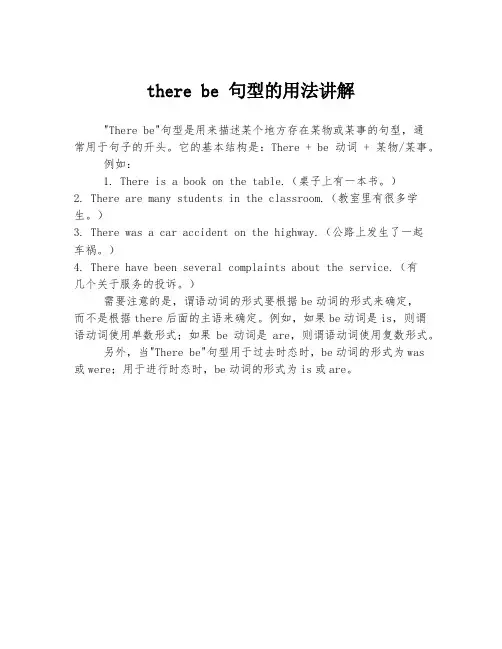
there be 句型的用法讲解
"There be"句型是用来描述某个地方存在某物或某事的句型,通
常用于句子的开头。
它的基本结构是:There + be动词 + 某物/某事。
例如:
1. There is a book on the table.(桌子上有一本书。
)
2. There are many students in the classroom.(教室里有很多学生。
)
3. There was a car accident on the highway.(公路上发生了一起
车祸。
)
4. There have been several complaints about the service.(有
几个关于服务的投诉。
)
需要注意的是,谓语动词的形式要根据be动词的形式来确定,
而不是根据there后面的主语来确定。
例如,如果be动词是is,则谓语动词使用单数形式;如果be动词是are,则谓语动词使用复数形式。
另外,当"There be"句型用于过去时态时,be动词的形式为was
或were;用于进行时态时,be动词的形式为is或are。
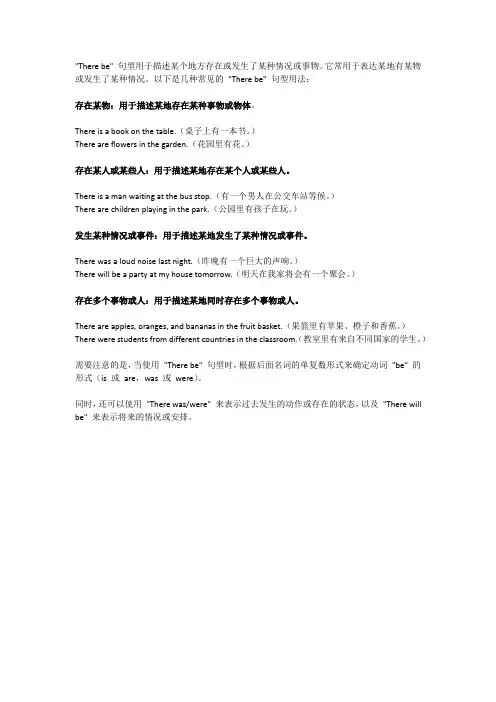
"There be" 句型用于描述某个地方存在或发生了某种情况或事物。
它常用于表达某地有某物或发生了某种情况。
以下是几种常见的"There be" 句型用法:存在某物:用于描述某地存在某种事物或物体。
There is a book on the table.(桌子上有一本书。
)There are flowers in the garden.(花园里有花。
)存在某人或某些人:用于描述某地存在某个人或某些人。
There is a man waiting at the bus stop.(有一个男人在公交车站等候。
)There are children playing in the park.(公园里有孩子在玩。
)发生某种情况或事件:用于描述某地发生了某种情况或事件。
There was a loud noise last night.(昨晚有一个巨大的声响。
)There will be a party at my house tomorrow.(明天在我家将会有一个聚会。
)存在多个事物或人:用于描述某地同时存在多个事物或人。
There are apples, oranges, and bananas in the fruit basket.(果篮里有苹果、橙子和香蕉。
)There were students from different countries in the classroom.(教室里有来自不同国家的学生。
)需要注意的是,当使用"There be" 句型时,根据后面名词的单复数形式来确定动词"be" 的形式(is 或are,was 或were)。
同时,还可以使用"There was/were" 来表示过去发生的动作或存在的状态,以及"There will be" 来表示将来的情况或安排。
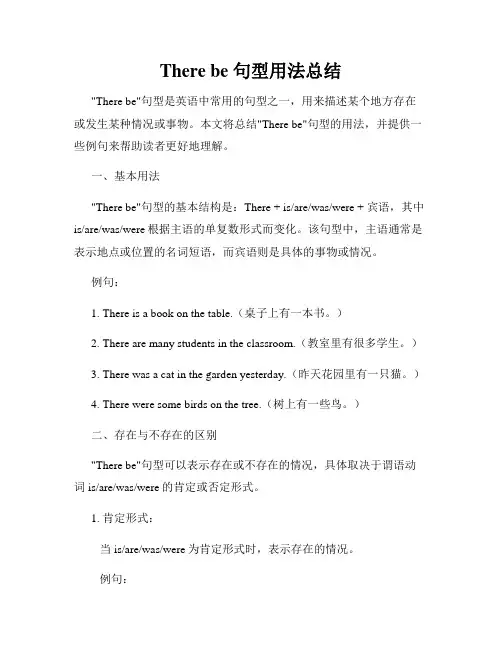
There be 句型用法总结"There be"句型是英语中常用的句型之一,用来描述某个地方存在或发生某种情况或事物。
本文将总结"There be"句型的用法,并提供一些例句来帮助读者更好地理解。
一、基本用法"There be"句型的基本结构是:There + is/are/was/were + 宾语,其中is/are/was/were根据主语的单复数形式而变化。
该句型中,主语通常是表示地点或位置的名词短语,而宾语则是具体的事物或情况。
例句:1. There is a book on the table.(桌子上有一本书。
)2. There are many students in the classroom.(教室里有很多学生。
)3. There was a cat in the garden yesterday.(昨天花园里有一只猫。
)4. There were some birds on the tree.(树上有一些鸟。
)二、存在与不存在的区别"There be"句型可以表示存在或不存在的情况,具体取决于谓语动词is/are/was/were的肯定或否定形式。
1. 肯定形式:当is/are/was/were为肯定形式时,表示存在的情况。
例句:1. There is a park near my house.(我的家附近有一个公园。
)2. There are some flowers in the garden.(花园里有一些花。
)3. There was a party in the hotel last night.(昨晚宾馆里开了一个派对。
)4. There were many people at the beach.(海滩上有很多人。
)2. 否定形式:当is/are/was/were为否定形式时,表示不存在的情况。
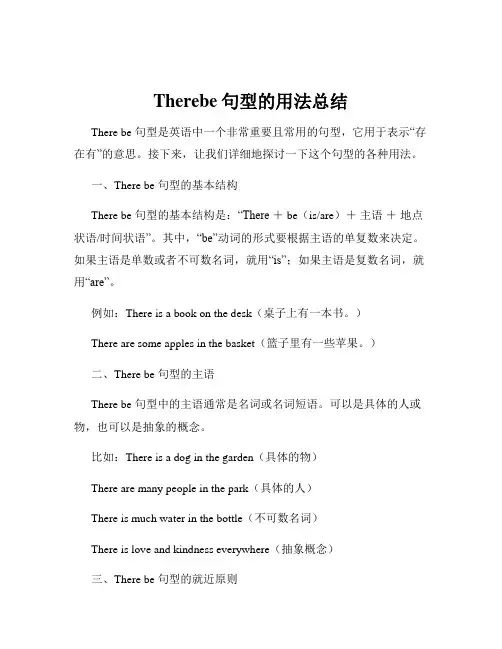
Therebe句型的用法总结There be 句型是英语中一个非常重要且常用的句型,它用于表示“存在有”的意思。
接下来,让我们详细地探讨一下这个句型的各种用法。
一、There be 句型的基本结构There be 句型的基本结构是:“There + be(is/are)+主语+地点状语/时间状语”。
其中,“be”动词的形式要根据主语的单复数来决定。
如果主语是单数或者不可数名词,就用“is”;如果主语是复数名词,就用“are”。
例如:There is a book on the desk(桌子上有一本书。
)There are some apples in the basket(篮子里有一些苹果。
)二、There be 句型的主语There be 句型中的主语通常是名词或名词短语。
可以是具体的人或物,也可以是抽象的概念。
比如:There is a dog in the garden(具体的物)There are many people in the park(具体的人)There is much water in the bottle(不可数名词)There is love and kindness everywhere(抽象概念)三、There be 句型的就近原则在 There be 句型中,当有两个或两个以上的主语时,“be”动词的形式要与离它最近的主语保持一致。
这就是所谓的就近原则。
例如:There is a pen and two books on the table(离“be”动词最近的主语是“a pen”,是单数,所以用“is”)There are two books and a pen on the table(离“be”动词最近的主语是“two books”,是复数,所以用“are”)四、There be 句型的否定形式There be 句型的否定形式是在“be”动词后面加上“not”,可以缩写成“isn't”或“aren't”。
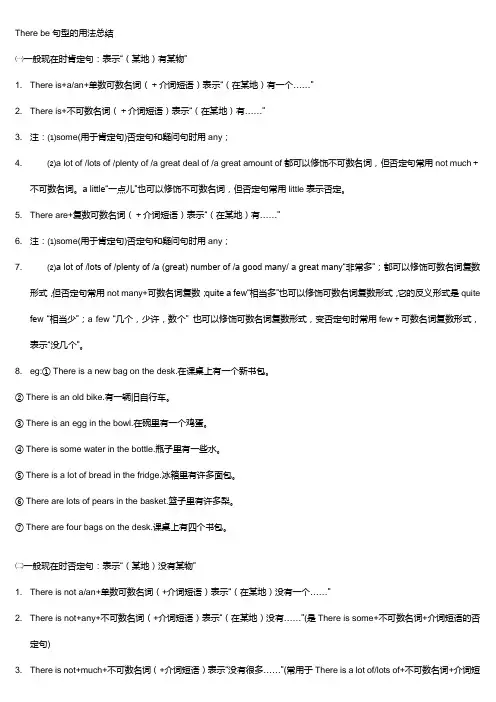
There be句型的用法总结㈠一般现在时肯定句:表示“(某地)有某物”1. There is+a/an+单数可数名词(+介词短语)表示“(在某地)有一个……”2. There is+不可数名词(+介词短语)表示“(在某地)有……”3. 注:⑴some(用于肯定句)否定句和疑问句时用any;4. ⑵a lot of /lots of /plenty of /a great deal of /a great amount of都可以修饰不可数名词,但否定句常用not much+不可数名词。
a little“一点儿”也可以修饰不可数名词,但否定句常用little表示否定。
5. There are+复数可数名词(+介词短语)表示“(在某地)有……”6. 注:⑴some(用于肯定句)否定句和疑问句时用any;7. ⑵a lot of /lots of /plenty of /a (great) number of /a good many/ a great many“非常多”;都可以修饰可数名词复数形式,但否定句常用not many+可数名词复数;quite a few“相当多”也可以修饰可数名词复数形式,它的反义形式是quite few “相当少”;a few “几个,少许,数个” 也可以修饰可数名词复数形式,变否定句时常用few+可数名词复数形式,表示“没几个”。
8. eg:① There is a new bag on the desk.在课桌上有一个新书包。
② There is an old bike.有一辆旧自行车。
③ There is an egg in the bowl.在碗里有一个鸡蛋。
④ There is some water in the bottle.瓶子里有一些水。
⑤ There is a lot of bread in the fridge.冰箱里有许多面包。
⑥ There are lots of pears in the basket.篮子里有许多梨。
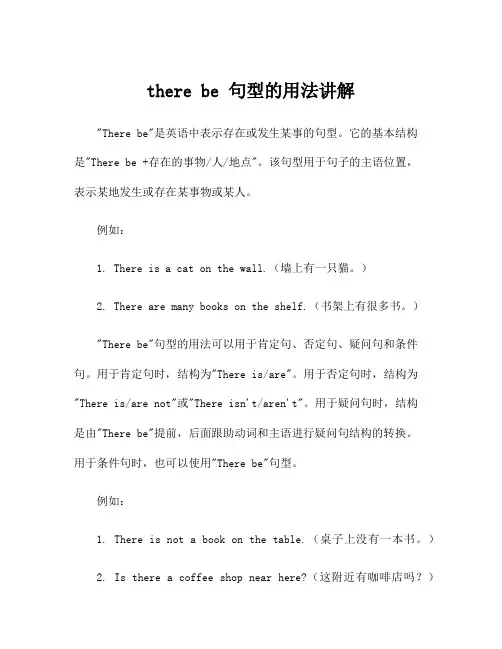
there be 句型的用法讲解"There be"是英语中表示存在或发生某事的句型。
它的基本结构是"There be +存在的事物/人/地点"。
该句型用于句子的主语位置,表示某地发生或存在某事物或某人。
例如:1. There is a cat on the wall.(墙上有一只猫。
)2. There are many books on the shelf.(书架上有很多书。
)"There be"句型的用法可以用于肯定句、否定句、疑问句和条件句。
用于肯定句时,结构为"There is/are"。
用于否定句时,结构为"There is/are not"或"There isn't/aren't"。
用于疑问句时,结构是由"There be"提前,后面跟助动词和主语进行疑问句结构的转换。
用于条件句时,也可以使用"There be"句型。
例如:1. There is not a book on the table.(桌子上没有一本书。
)2. Is there a coffee shop near here?(这附近有咖啡店吗?)3. If there is a problem, let me know.(如果有问题,请告诉我。
)除了基本的句型用法之外,可以在"There be"句型中加入修饰词和定语从句来进行拓展。
修饰词可以用来描述存在的物体的特征或数量,定语从句可以进一步描述关于存在的事物的信息。
例如:1. There is a big black dog in the backyard.(后院有一只又大又黑的狗。
)2. There are some students in the classroom who are studying.(教室里有一些正在学习的学生。
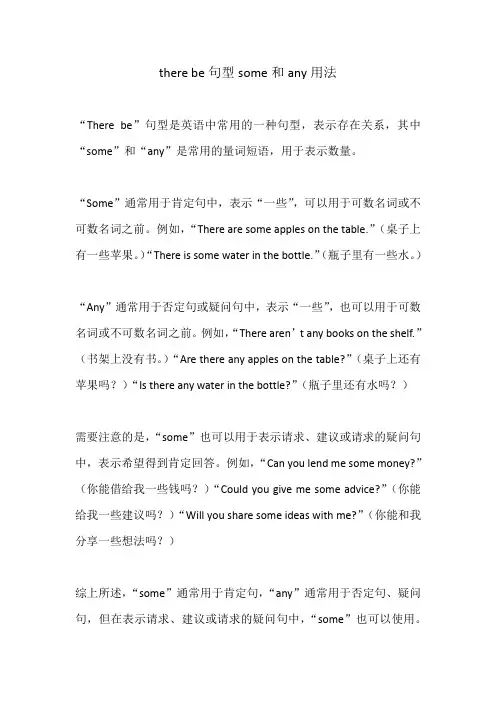
there be句型some和any用法
“There be”句型是英语中常用的一种句型,表示存在关系,其中“some”和“any”是常用的量词短语,用于表示数量。
“Some”通常用于肯定句中,表示“一些”,可以用于可数名词或不可数名词之前。
例如,“There are some apples on the table.”(桌子上有一些苹果。
)“There is some water in the bottle.”(瓶子里有一些水。
)
“Any”通常用于否定句或疑问句中,表示“一些”,也可以用于可数名词或不可数名词之前。
例如,“There aren’t any books on the shelf.”(书架上没有书。
)“Are there any apples on the table?”(桌子上还有苹果吗?)“Is there any water in the bottle?”(瓶子里还有水吗?)
需要注意的是,“some”也可以用于表示请求、建议或请求的疑问句中,表示希望得到肯定回答。
例如,“Can you lend me some money?”(你能借给我一些钱吗?)“Could you give me some advice?”(你能给我一些建议吗?)“Will you share some ideas with me?”(你能和我分享一些想法吗?)
综上所述,“some”通常用于肯定句,“any”通常用于否定句、疑问句,但在表示请求、建议或请求的疑问句中,“some”也可以使用。
在选择使用“some”或“any”时,应该根据句子的时态、主语的人称和数进行判断。
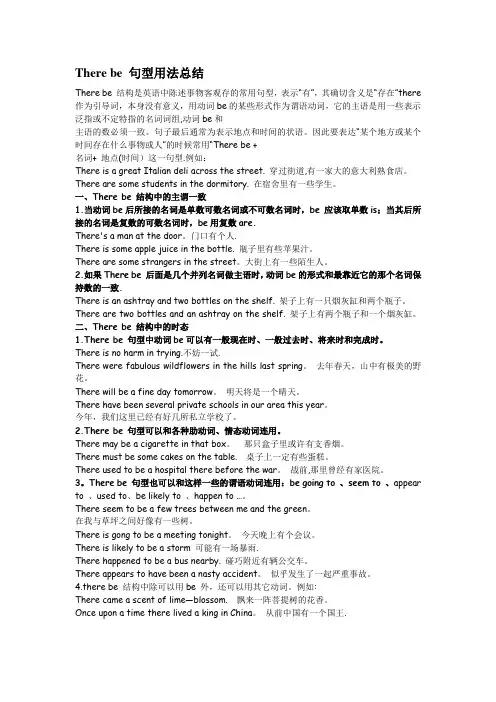
There be 句型用法总结There be 结构是英语中陈述事物客观存的常用句型,表示“有”,其确切含义是“存在”there 作为引导词,本身没有意义,用动词be的某些形式作为谓语动词,它的主语是用一些表示泛指或不定特指的名词词组,动词be和主语的数必须一致。
句子最后通常为表示地点和时间的状语。
因此要表达“某个地方或某个时间存在什么事物或人”的时候常用“There be +名词+ 地点(时间)这一句型.例如:There is a great Italian deli across the street. 穿过街道,有一家大的意大利熟食店。
There are some students in the dormitory. 在宿舍里有一些学生。
一、There be 结构中的主谓一致1.当动词be后所接的名词是单数可数名词或不可数名词时,be 应该取单数is;当其后所接的名词是复数的可数名词时,be用复数are.There's a man at the door。
门口有个人.There is some apple juice in the bottle. 瓶子里有些苹果汁。
There are some strangers in the street。
大街上有一些陌生人。
2.如果There be 后面是几个并列名词做主语时,动词be的形式和最靠近它的那个名词保持数的一致.There is an ashtray and two bottles on the shelf. 架子上有一只烟灰缸和两个瓶子。
There are two bottles and an ashtray on the shelf. 架子上有两个瓶子和一个烟灰缸。
二、There be 结构中的时态1.There be 句型中动词be可以有一般现在时、一般过去时、将来时和完成时。
There is no harm in trying.不妨一试.There were fabulous wildflowers in the hills last spring。
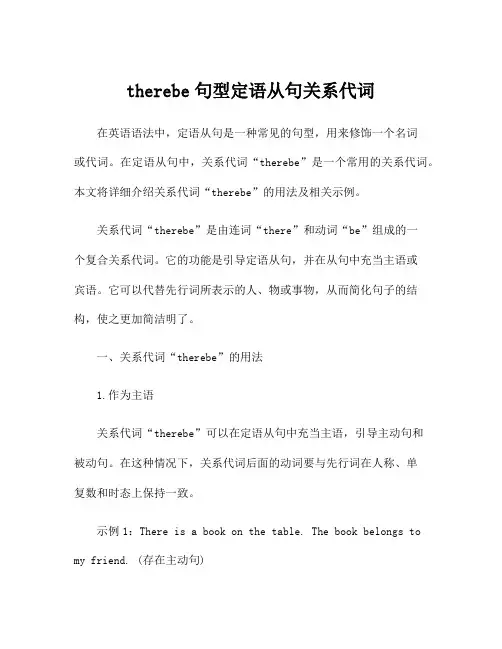
therebe句型定语从句关系代词在英语语法中,定语从句是一种常见的句型,用来修饰一个名词或代词。
在定语从句中,关系代词“therebe”是一个常用的关系代词。
本文将详细介绍关系代词“therebe”的用法及相关示例。
关系代词“therebe”是由连词“there”和动词“be”组成的一个复合关系代词。
它的功能是引导定语从句,并在从句中充当主语或宾语。
它可以代替先行词所表示的人、物或事物,从而简化句子的结构,使之更加简洁明了。
一、关系代词“therebe”的用法1.作为主语关系代词“therebe”可以在定语从句中充当主语,引导主动句和被动句。
在这种情况下,关系代词后面的动词要与先行词在人称、单复数和时态上保持一致。
示例1:There is a book on the table. The book belongs to my friend. (存在主动句)→ There is a book on the table that belongs to my friend. (存在关系代词定语从句)示例2:There were some flowers in the garden. The flowers were picked by my sister. (存在被动句)→ There were some flowers in the garden that were picked by my sister. (存在关系代词定语从句)2.作为宾语关系代词“therebe”可以在定语从句中充当宾语,修饰介词或及物动词。
在这种情况下,关系代词后面的动词要与先行词在人称、单复数和时态上保持一致。
示例3:There is an apple. I want to eat the apple. (存在介词宾语)→ There is an apple that I want to eat. (存在关系代词定语从句)示例4:There is a movie. I watched the movie last night. (存在及物动词宾语)→ There is a movie that I watched last night. (存在关系代词定语从句)二、关系代词“therebe”的使用注意事项1.关系代词“therebe”只能用于引导非限制性定语从句,不能用于引导限制性定语从句。
therebe句型用法总结"there be"句型用法总结如下:1. "there be"是一种特殊的句型,用来表达某个地方存在或出现了某物或某人。
结构为"There + be动词+ 存在的事物或人"。
例如:There is a cat in the garden.(花园里有一只猫。
)2. "there be"句型的一般现在时表示现在或经常性的存在。
一般过去时表示过去某个时间点的存在。
一般将来时表示将来的存在。
例如:There will be a party in the evening.(晚上将会有一个派对。
)3. "there be"句型的否定形式是"There + be动词的否定形式 +存在的事物或人"。
疑问形式是"Is/Are + there +存在的事物或人+其他成分"。
回答时直接根据句子情况回答即可。
例如:否定形式:There isn't a book on the desk.(桌子上没有一本书。
)疑问形式:Is there a pen on the table?(桌子上有一支笔吗?)4. "there be"句型中,be动词的形式根据后面的名词数目变化。
如果后面是单数名词,则用is;如果后面是复数名词,则用are。
例如:There is a book on the shelf.(书架上有一本书。
)There are books on the shelf.(书架上有几本书。
)5. "there+be"还可以用于表示存在的程度或数量。
在句子中可以使用一些描述词语来修饰。
例如:There are so many people at the concert.(音乐会上有很多人。
)There is only one apple left in the basket.(篮子里只剩下一个苹果了。
There-be-句型用法总结Therebe 句型用法总结There be 句型是英语中常用的一种表示“存在”的句型,它在日常交流和书面表达中都有着广泛的应用。
掌握 There be 句型的用法对于学好英语至关重要。
下面就为大家详细总结一下 There be 句型的用法。
一、There be 句型的基本结构There be 句型的基本结构为:There + be(is/are)+名词+地点状语/时间状语。
其中,“there”在句中没有实际意义,只是一个引导词,“be”是谓语动词,其形式要根据后面的名词来决定。
如果名词是单数或不可数名词,就用“is”;如果名词是复数,就用“are”。
例如:There is a book on the desk(桌子上有一本书。
)There are some apples in the basket(篮子里有一些苹果。
)二、There be 句型的否定形式There be 句型的否定形式是在“be”动词后面加上“not”,即:There+ be + not +名词+地点状语/时间状语。
例如:There isn't a pen in the pencil box(铅笔盒里没有钢笔。
)There aren't any flowers in the garden(花园里没有花。
)三、There be 句型的一般疑问句There be 句型的一般疑问句是把“be”动词提到“there”前面,即:Be + there +名词+地点状语/时间状语?其肯定回答是:Yes, there +be 否定回答是:No, there + be + not例如:Is there a library in your school? (你们学校有图书馆吗?)Yes, there is (是的,有。
)No, there isn't (不,没有。
)Are there any students in the classroom? (教室里有学生吗?)Yes, there are (是的,有。
Therebe句型的用法总结
"there be"句型用于表达存在物或人的情况,常常用来描述地或其中一种情景中存在的事物。
其句型结构为:
例如:
1. There is a cat on the table.(桌子上有一只猫。
)
2. There are some books on the shelf.(书架上有一些书。
)
3. There used to be a park here.(这里曾经有一个公园。
)
4. There will be a meeting tomorrow.(明天将有一场会议。
)需要注意的几点是:
1. "be"动词的形式根据主语的单复数变化。
当主语是单数时,用"is";当主语是复数时,用"are"。
2. "be"动词后面的名词可以用不定冠词或定冠词修饰,也可以是复数形式。
此外,还可以使用形容词修饰名词,形容词还可以用来描述主语的状态或特征。
3. "there be"句型也可以用于过去时态、进行时态和将来时态,只需要根据情况改变be动词的时态或人称形式。
希望能帮到你!。
There be句型的用法总结There be句型是英语中常用的一种说法形式,用来描述某个地方存在或发生的事物、人或情况。
该句型通常由“There”和“be”组成,后面跟着一个名词或名词短语。
本文将对There be句型的用法进行总结,以便读者更好地理解和运用。
一、肯定句的用法在肯定句中,There be句型用来表达某地存在某个或某些事物、人或情况。
常见的用法有以下几种:1. There is + 单数名词(或不可数名词)例如:There is a book on the table.(桌子上有一本书。
)2. There are + 复数名词例如:There are two dogs in the garden.(花园里有两只狗。
)3. There is + 不可数名词例如:There is some milk in the fridge.(冰箱里有一些牛奶。
)4. There are + 可数名词复数例如:There are books on the bookshelf.(书架上有一些书。
)二、否定句的用法在否定句中,There be句型用来表达某地不存在某个或某些事物、人或情况。
常见的用法有以下几种:1. There isn't + 单数名词(或不可数名词)例如:There isn't a book on the table.(桌子上没有一本书。
)2. There aren't + 复数名词例如:There aren't any dogs in the garden.(花园里没有狗。
)3. There isn't + 不可数名词例如:There isn't any milk in the fridge.(冰箱里没有牛奶。
)4. There aren't + 可数名词复数例如:There aren't any books on the bookshelf.(书架上没有书。
Therebe句型的用法总结There be 句型是英语中一个非常重要的句型,它用来表示“某地有某物/某人”。
掌握好 There be 句型对于我们准确、流畅地表达英语句子有着重要的意义。
接下来,就让我们一起详细地了解一下 There be 句型的各种用法。
一、There be 句型的基本结构There be 句型的基本结构是“There + be(is/are)+主语+地点状语/时间状语”。
其中,be 动词的形式要根据主语的单复数来决定。
如果主语是单数名词或不可数名词,就用 is;如果主语是复数名词,就用 are。
例如:There is a book on the desk(桌子上有一本书。
)There are some apples in the basket(篮子里有一些苹果。
)二、There be 句型的否定形式There be 句型的否定形式是在 be 动词后面加 not,即“There + be(is/are)+ not +主语+地点状语/时间状语”。
例如:There isn't a pen in the pencil case(铅笔盒里没有一支钢笔。
)There aren't any students in the classroom(教室里没有学生。
)三、There be 句型的一般疑问句There be 句型的一般疑问句是把 be 动词提到 there 前面,即“Be(Is/Are)+ there +主语+地点状语/时间状语?”回答用 Yes, there is/are 或者 No, there isn't/aren't例如:Is there a library in your school? (你们学校有图书馆吗?)Yes, there is (是的,有。
)Are there any flowers in the garden? (花园里有花吗?)No, there aren't (不,没有。
therebe句型and和or用法
在英语中,"There be" 句型用于描述某处存在某物。
在这个句型中,"and" 和 "or" 的用法有一些特殊之处。
1. "and" 的用法:
在 "There be" 句型中,"and" 用于连接两个或多个名词,表示这些名词都存在于某处。
例如:
```arduino
There is a book and a pen on the table.
```
在这个句子中,"and" 连接了 "book" 和 "pen",表示这两样东西都存在于桌子上。
2. "or" 的用法:
在 "There be" 句型中,"or" 用于连接两个或多个名词,表示其中任何一个存在于某处。
例如:
```arduino
There is a book or a pen on the table.
```
在这个句子中,"or" 连接了 "book" 和 "pen",表示桌子上有其中一本书或一支笔,或者两者都有。
需要注意的是,"or" 通常用于表示两种可能性之一,而不是两者都存在。
如果表示两者都存在,通常使用 "and" 来连接。
1 There be句型的用法 一、构成:There be ...句型表示的是 “某处有(存在)某人或某物”,其结构为There be(is,are )+名词+地点状语。例如: 1) There are fifty-two students in our class. 2) There is a pencil in my pencil-case. 二、各种句式: 否定句:在be后加上“not”,也可用“no”来表示。即:no + n.(名词)= not a\an\any + n.(名词)。例如: 1) There is an orange in her bag. →There isn’t an orange in her bag. →There is no orange in her bag. 2) There are some oranges in her bag. →There aren’t any oranges in her bag. →There are no oranges in her bag. 3) There is some juice in the bottle. →There isn’t any juice in the bottle. →There is no juice in the bottle. 一般疑问句:There be结构的一般疑问句变化只需把be动词移到句首,再在句尾加上问号即可。例如: 4) There is some money in her handbag. → Is there any money in her handbag? (疑问句和否定句中,some改为any, something改为anything.) 5) There is something new in today’s newspaper. →Is there anything new in today’s newspaper? 特殊疑问句:There be句型的特殊疑问句有以下三种形式 ① 对主语提问:当主语是人时,用 “Who’s + 介词短语?”;当主语是物时,用 “What’s + 介词短语?”。其中there在口语中常常省略。注意:无论原句的主语是单数还是复数,对其提问时一般都用be的单数形式(回答时却要根据实际情况来决定)。如: 6) There is a bird in the tree. →What’s in the tree? 7) There are some bikes over there. →What’s over there? 8) There is a little girl in the room. →Who is in the room? ② 对地点状语提问:用 “Where is \ are + 主语?”表示(注意其答语变化):例如: 9) There is a computer in my office. → Where is the computer? ----It’s in my office. 10) There are four children in the classroom. →Where are the four children? --They’ re in the classroom. ③ 对数量提问:一般有两种提问方式: 如果主语是可数名词,无论是单数还是复数,都用“How many +可数名词复数 + are there + 介词短语?”表示: 11) There are twelve months in a year. →How many months are there in a year? 12) There is only one book in my bag. → How many books are there in your bag? 2
13) There is a cat in the box. → How many cats are there in the box? 如果主语是不可数名词,则用“ How much + 不可数名词 + is there + 介词短语?”表示: 14) There is some money in my purse. → How much money is there in your purse? 三、用法: 1. There be句型中be动词的形式要和其后的主语在人称和数上保持一致。 1) There is a basketball in the box. 2) There is a little milk in the glass. 3) There are many birds in the tree. 如果有两个或两个以上的名词作主语,be动词要和最靠近它的那个主语在数上保持一致,也就是我们常说的 “就近原则”。例如: 5) There is an orange and some bananas in the basket. 6) There are some bananas and an orange in the basket. 2.There be +名词+地点/时间状语 There was a party in the hall last night. 3.由there be构成的固定句型 There is something wrong with … = Something is wrong with … There is something wrong with my bike. = Something is wrong with my bike There is\are sb \sth doing sth . There is a bird singing in the tree. 7. There be句型和have\has的区别:There be句型表示 “存在有”, have\has表示 “拥有” “所有”,两者不能同时使用.例如: 1) The tree has many apples on it. 2) There are many apples on the tree. 3) There have many apples on the tree.(×) 4) There’s a picture on the wall. 5) There are six rooms in this house.
选择填空。 1.There ________ no tea in the cup. A.is B.are C.has D.be 2.There ________ in the next room. A.is Tom B.are some boys C.are they D.is the boy 3.There is some ________ on the plate. A.apple B.bread C.banana D.sandwich 4.There ________ some paper and a pen on the desk. A.is B.are C.have D.has 5.There ________ a school at the foot of the hill. A.have B.is C.are D.are 6.There's ________ with my car.. A. something wrong B. wrong something 3
C.anything wrong D.wrong anything 7.There isn’t______ milk in the bottle. A.some B.any C.lots of D.no 8. ________ is there on the table? A.How many apples B.How much bread C.How much breads D.How many food 9.There are sixty minutes in ________ hour. A.an B.the C.a D./ 10.There is ________ old woman in the car. A.× B.a C.the D.an 11.There's ________ orange tree behind ________ house. A.an ;the B.a;a C.the;the 12.There is ________ map in the classroom. ________ map is on the wall. A.a;A B.the;The C.a;The D.the;A 13.There is ________ “f”and ________ “u”in the word“four”. A.an;a B.a;a C.an;an D.a;an 14.There ________ not any water in the glass. A.has B.is C.are 15.There ________ a football match in our school this afternoon. A.are have B.is have C.are be D.is 16.There ________ an apple and ten bananas in the basket.You can take any of them. A.are B.is C.has D.have 17. ________ any flowers on both sides of the street? A.Is there B.Are there C.Has D.Have 18.There ________ some money in the purse. A.have B.is C.has D.are 19.There isn't ________ paper in the box.Will you go and get some for me? A.any B.some C.a D.an 20.There ________ some water in the bottle. A.are B.is C.has D.have 21.How many ________ are there in your classroom? A.desks B.desk C.chair D.door 22.There ________ something wrong with my car. A.are B.has C.is D.have 23.There ________ a pencil and two pens in the pencil-box. A.are B.has C.have D.is